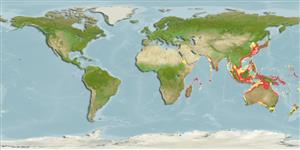Common names from other countries
Environment: milieu / climate zone / depth range / distribution range
Ecologie
; diepteverspreiding 0 - 100 m (Ref. 348). Tropical
Indo-West Pacific: from East Africa, to Melanesia; north to East China Sea and Japan, and south to Queensland and New Caledonia.
Length at first maturity / Size / Gewicht / Leeftijd
Maturity: Lm ? range ? - ? cm Max length : 5.0 cm SHL mannelijk/geslacht niet bekend; (Ref. 348); common length : 4.0 cm SHL mannelijk/geslacht niet bekend; (Ref. 348)
It is commonly collected for food in eastern Africa (Ref. 348). Subtidal, on sand (Ref. 75840). Also found in shelf zones (Ref. 348).
Life cycle and mating behavior
Geslachtsrijpheid | Voortplanting | Kuitschieten | Eieren | Fecundity | Larven
Members of the class Bivalvia are mostly gonochoric, some are protandric hermaphrodites. Life cycle: Embryos develop into free-swimming trocophore larvae, succeeded by the bivalve veliger, resembling a miniature clam.
Poutiers, J.M. 1998. (Ref. 348)
Status op de Rode Lijst van het IUCN (Ref. 130435)
Status bij CITES (Ref. 108899)
Not Evaluated
Not Evaluated
Gevaarlijk voor mensen
Harmless
Gebruik door de mens
| FishSource |
Tools
Meer informatie
Leeftijd/Grootte
Groei
Lengte-gewicht parameters
Lengte-lengte parameters
Morfologie
Larven
Abundantie
Internet-bronnen
Estimates based on models
Preferred temperature
(Ref.
115969): 23.1 - 29.1, mean 28 (based on 1996 cells).
Kwetsbaarheid
Low vulnerability (10 of 100).
